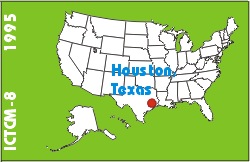
Electronic Proceedings of the Eighth Annual International Conference on Technology in Collegiate MathematicsHouston, Texas, November 16-19, 1995Paper C096Napoleon-Like Properties of Spherical Triangles |
Mark R. TreudenDepartment of Mathematics and Computing University of Wisconsin-Stevens Point Stevens Point, WI 54481-3897 USA Phone: (715) 346-3734 m2treude@uwspmail.uwsp.edu list of all papers by this author |
| Click to access this paper: |
ABSTRACT
If equilateral triangles are constructed outwards or inwards on the sides of any given triangle, the centroids of these triangles are the vertices of an equilateral triangle. In elementary Euclidean geometry this result is known as Napoleon's Theorem.Consider the following generalization of this construction. Let d(_,_) denote Euclidean distance and suppose A,B,C are the vertices of any given, positively oriented triangle. Let point X be located s units from A along line AB and t units perpendicular to line AB. Assume s,t are directed distances with s measured positively from A to B and t positive when measured outward from triangle ABC. With the same sign conventions, the point Y is located (s)d(B,C)/d(A,B) units from point B along line BC and (t)d(B,C)/d(A,B) units perpendicular to line BC. Similarly, point Z is located (s)d(C,A)/d(A,B) units from point C along line CA and (t)d(C,A)/d(A,B) units perpendicular to line CA. In this way the points X,Y,Z are proportionately positioned relative to the points A,B,C. Note that X,Y,Z are the centroids mentioned in Napoleon's Theorem when s=d(A,B)/2 and t=(+-)d(A,B)/(2(sqrt(3)). Are there other real numbers s,t for which triangle XYZ is equilateral? The answer to this question can be discovered by most any college geometry student aided with a computer algebra system (CAS).
In this paper we adapt the foregoing construction to certain classes of spherical triangles and use a CAS to determine various values of s,t with the properties given above.
Keyword(s): geometry, computer algebra systems, Mathematica
